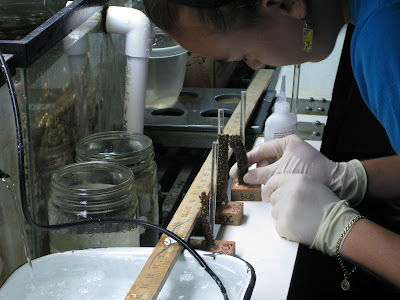The Hermatypic branch coral
Acropora yongei is a common reef coral that has bioluminescent endosymbiotic dinoflagellates that could potentially serve as visible stress and bleaching indicators.
 |
| Caroline and Dr. Deheyn happily working with probably not-so-happy corals |
 |
| Coral branches between 4 and 5 millimeters needed to be super-glued to these clay bases, on which they would grow, be experimented upon, and subsequently photographed under different fluorescent lights. |
 |
| There were a total of 80 clay bases that awaited coral branches. |
 |
| Bigger corals, that had been tended to and cultivated for weeks in advance, were pulled out of their comfortable tanks and isolated so that the right-sized branches could be clipped. When these corals are cut or injured, they secrete a sickly-sweet smelling mucus that covers the outside of the coral and spreads through the water. Since it is unknown whether or not the corals can communicate their distress to other corals, possibly via the mucus, the coral being cut is isolated in order not to stress out the others in the tank. |
 |
| The coral is isolated in a tank. |
 |
| A branch is measured. |
 |
| A pair of rather large wire-cutters is used to cut the branch off. |
 |
| The cut-off coral branch is already clothed in a covering a sticky mucus. |
 |
| The clipped coral branches are placed in a tray with sea-water circulation to ensure their healthiness (though maybe not happiness) until they're glued to the clay bases. |
 |
| The branch is re-measured. |
 |
| Some glue is applied to the clay base and the bottom of the coral. |
 |
| In the end, we used some glue we borrowed from a lab on one of the upper floors. Its custom made label dubbed it "Reef CA Frag Glue." It had a very thin consistency, but worked really well. |




























































No comments:
Post a Comment